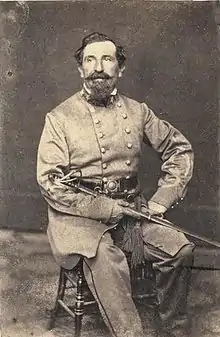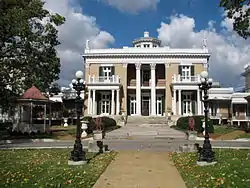Adolphus Heiman | |
|---|---|
 Col. Adolphus Heiman | |
| Born | April 17, 1809 Potsdam, Prussia |
| Died | November 16, 1862 (aged 53) Jackson, Mississippi |
| Buried | |
| Allegiance | |
| Service/ | |
| Years of service | 1846–1847 1861–1862 |
| Rank | First Lieutenant (USV) Bvt. major (USV) Colonel (CSA) Brigadier general (not substantiated) |
| Unit | 1st Tennessee Volunteer Infantry (USA) |
| Commands held | 10th Tennessee Infantry (CSA) 1st Brigade / Left Wing / Army of Central Kentucky |
| Battles/wars | |
| Other work | architect, engineer |
Adolphus Heiman (April 17, 1809 – November 16, 1862) was a Prussian-born American architect and soldier; later becoming a Confederate officer during the American Civil War.[1][2][3][4][5]
Early life
Adolphus Heiman was born in Potsdam, Prussia on April 17, 1809.[1][4][5] His father was a building superintendent.[3] He emigrated to the United States in 1834, spent time in New York City and New Orleans, and settled in Nashville, Tennessee in 1837.[1][3][5]
Career
From 1837 to 1841, Heiman built the First Baptist Church on Fifth Avenue, which was destroyed in 1940, and tombstones in the Old City Cemetery on Fourth Avenue South in Nashville.[1][2]
Heiman volunteered for service in the Mexican–American War of 1846–48. He was commissioned as a First Lieutenant in the 1st Regiment of Tennessee Volunteers. He became the regimental Adjutant and was wounded in the Battle of Cerro Gordo.[6] He was wounded again at the Battle of Monterrey. When the war ended he was breveted as Major.[1][3][4]

In 1849, he was commissioned to build a Gothic Revival 250-bed state Hospital for the Insane.[1][3][5] He also designed the Cathedral of Our Lady of the Seven Dolors (now known as St. Mary's Catholic Church), the now-demolished Italianate-style Adelphi Theater, the Greek Revival-style Medical Department and the Gothic Revival-style Literary Department at the University of Nashville, and the Italianate-style Belmont Mansion.[1][3][5][7] He also designed the Giles County Courthouse in Pulaski, Tennessee, St. John's College in Little Rock, Arkansas and the Arkansas Masonic School, and the First Presbyterian Church in Huntsville, Alabama.[1][8] He also designed the first suspension bridge in Tennessee over the Cumberland River.[1][9] By the 1850s, he was widely known as "Nashville's architect."[2] Residing in the city, Heiman also was a freemason as member of the local Cumberland Lodge No 8.[10]
Civil War
Heiman served in the Confederate States Army during the American Civil War. Initially commissioned a Major in the Provisional Army of Tennessee; he served as an aide-de-camp to Brigadier Robert G. Foster before becoming an assistant adjutant-general of the Tennessee Military Department with the rank of colonel.[11][12] When the 10th Tennessee Infantry Regiment was raised he was elected as its colonel and commanding officer.[1][3][4][13][14] When the regiment was stationed at Fort Henry; Heiman built Fort Heiman on the opposite bank of the river. When the Union Army emerged for the Battle of Fort Henry the regiment transferred to Fort Donelson where Heiman was given command of the brigade to which his regiment was assigned. When the fort surrendered in February 1862 he became a prisoner of war at Fort Warren in Boston and, gravely ill, was released after six months.[1]
Death
Heiman immediately was put into a Confederate hospital in Jackson, Mississippi. He died there on November 16, 1862, six days after being re-elected colonel of the newly exchanged 10th Tennessee. A promotion to brigadier general had been hinted but not substantiated with evidence.[15] He was buried in the Confederate Circle of Mount Olivet Cemetery in Nashville in 1869.[1]
References
- 1 2 3 4 5 6 7 8 9 10 11 12 The Tennessee Encyclopedia of History and Culture
- 1 2 3 The Nashville City Cemetery Association
- 1 2 3 4 5 6 7 Nashville Public Television: Nashville Architects Archived 2013-10-24 at the Wayback Machine
- 1 2 3 4 Myers E. Brown, II, Tennessee's Confederates, Arcadia Publishing, 2011, p. 81
- 1 2 3 4 5 Christine Kreyling (ed.), Classical Nashville: Athens of the South, Nashville, Tennessee: Vanderbilt University Press, 1996, pp. 48-51
- ↑ Robarts, William H. (1887). Mexican War veterans : a complete roster of the regular and volunteer troops in the war between the United States and Mexico, from 1846 to 1848 ; the volunteers are arranged by states, alphabetically. Washington, DC: Brentano's. p. 72. Retrieved 5 July 2016.
- ↑ A. W. F. Edwards, Nashville Interiors: 1866 To 1922, Arcadia Publishing, 1999, p. 11
- ↑ Robert S. Gamble, Historic Architecture in Alabama: A Guide to Styles and Types, 1810-1930, Tuscaloosa, Alabama: University of Alabama Press, 2001, p. 84
- ↑ "The Suspension Bridge at Nashville". Archived from the original on 2013-04-09. Retrieved 2018-10-03.
- ↑ Smart, C.H., Secretary (1914). Roster of Cumberland lodge, no. 8, F. and A. M., from June 24, 1812, to June 24, 1912. Nashville, TN: Cullon & Ghertner Co. p. 14. Retrieved 5 July 2016.
{{cite book}}: CS1 maint: multiple names: authors list (link) - ↑ Gen. Wright, Marcus J. (1908). Tennessee in the war, 1861-1865; lists of military organizations and officers from Tennessee in both the Confederate and Union armies; general and staff officers of the provisional army of Tennessee, appointed by Governor Isham G. Harris. New York, NY: Lee publishing company. p. 20. Retrieved 5 July 2016.
- ↑ Col. Hall, Charles W.L. (2013). Coopers adjutants -- and the unsung heroics and deeds of clerks in gray! : a history of the life and times of General Samuel Cooper, AG. Bloomington, IN: Trafford Publishing. p. 102. ISBN 9781466978720.
- ↑ Thomas Lawrence Connelly, Army of the Heartland: The Army of Tennessee, 1861-1862, Baton Rouge, Louisiana: Louisiana State University Press, 1 Sep 2001, p. 38
- ↑ Helen P. Trimpi, Crimson Confederates: Harvard Men Who Fought for the South, Knoxville, Tennessee: University of Tennessee Press, 2010, p. 204
- ↑
- Eicher, John H., and David J. Eicher, Civil War High Commands. Stanford: Stanford University Press, 2001. ISBN 978-0-8047-3641-1., p. 600